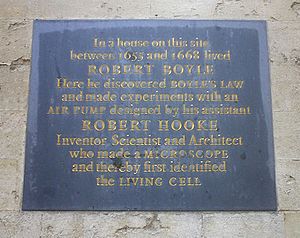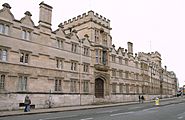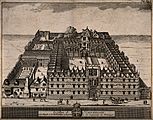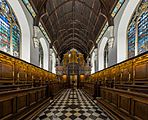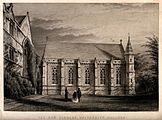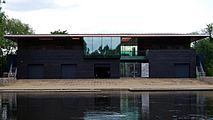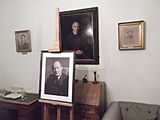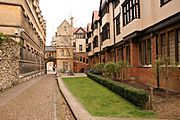University College, Oxford facts for kids
Quick facts for kids University College |
||||||
|---|---|---|---|---|---|---|
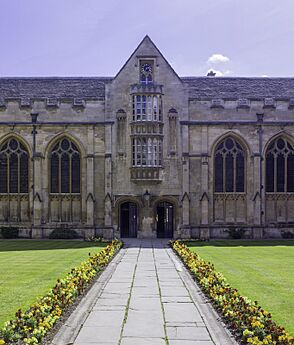
Main Quadrangle of University College
|
||||||
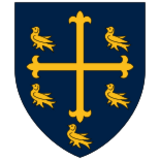
Blazon: Azure, a cross patonce between four [sometimes five] martlets Or.
|
||||||
|
|
||||||
| University | University of Oxford | |||||
| Location | High Street, Oxford OX1 4BH | |||||
| Coordinates | 51°45′09″N 1°15′07″W / 51.7525°N 1.2520°W | |||||
| Full name | The College of the Great Hall of the University of Oxford | |||||
| Latin name | Collegium Magnae Aulae Universitatis Oxon. | |||||
| Established | 1249 | |||||
| Sister college | Trinity Hall, Cambridge | |||||
| Master | Valerie Amos, Baroness Amos | |||||
| Undergraduates | 425 (2023–24) | |||||
| Postgraduates | 219 (2023–24) | |||||
| JCR | Univ JCR | |||||
| MCR | Univ WCR | |||||
| Boat club | University College Boat Club | |||||
| Map | ||||||
University College, often called "Univ", is one of the oldest colleges at the University of Oxford in England. Its full name is "The Master and Fellows of the College of the Great Hall of the University commonly called University College in the University of Oxford."
It was founded in 1249 by William of Durham. As of 2023, the college had a large financial fund of over £146 million. Many famous people have studied at Univ, including former UK Prime Ministers Clement Attlee and Harold Wilson. Other notable alumni include Bill Clinton, Stephen Hawking, and C. S. Lewis.
Contents
History of Univ
A old story from the 1300s says that King Alfred founded the college in 872. This is why the college's shield uses symbols linked to King Alfred. It's also why the current King or Queen is always the college's official "Visitor." The college even celebrated its 1000th birthday in 1872 because of this legend.
However, most people agree that William of Durham actually founded Univ in 1249. He left money to help ten or twelve masters of arts study theology. A building called Aula Universitatis (University Hall) was bought in 1253. This founding date still allows Univ to claim it is the oldest Oxford college. Other colleges like Balliol College and Merton College also claim this title. For a long time, until the 1500s, Univ was only for students studying theology.
The college bought more land on its current site in 1332 and 1336. They built a main quadrangle (a courtyard surrounded by buildings) in the 1400s. As the college grew, its old buildings were replaced. The current Main Quadrangle was built in the 1600s. Construction started in 1634 but was delayed by the English Civil War. It was finally finished around 1676. The Radcliffe Quad was built more quickly by 1719, and the library was added in 1861.
Like many Oxford colleges, University College started accepting both male and female students in 1979. Before that, it was only for men.
Buildings and Grounds
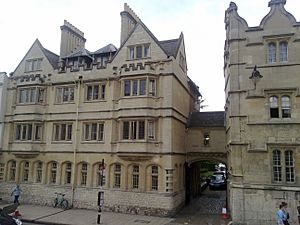
The main entrance to University College is on High Street. The college grounds are also next to Merton Street and Magpie Lane. A lane called Logic Lane runs through the middle of the college. The college owns this lane.
On the western side of the college, you'll find the library, the dining hall, and the chapel. There are also two quadrangles with student rooms and college offices. The eastern side of the college mainly has student rooms. These rooms are above shops on High Street, on Merton Street, or in the Goodhart Building. This building is named after Arthur Lehman Goodhart, a former head of the college.
Inside the college, there is a special building called the Shelley Memorial. It holds a statue of the poet Percy Bysshe Shelley. He was a student at Univ but was expelled for writing a paper called The Necessity of ... in 1811. The statue shows Shelley lying dead on an Italian beach.
The college also has an annexe (an extra building) on Staverton Road in North Oxford. This building houses second-year undergraduate students and some graduate students.
Univ also owns the University College Boathouse, which was finished in 2007. There is also a sports ground nearby on Abingdon Road.
Student Life
Univ Alternative Prospectus
The "Alternative Prospectus" is a guide written by current students for people who want to apply to Univ. It gives advice and tips from a student's point of view. In 2011, this publication won an award for being innovative and well-made. The award recognized how the college community worked together on it.
College Grace
University College has the longest "grace" (a prayer said before meals) of any college in Oxford. It is said before every "Formal Hall." Formal Hall is a special dinner held on Tuesdays, Thursdays, and Sundays. A "Scholar" (a student who has won an academic award) reads the grace. The person sitting at the head of the "High Table" (usually the Master of the college or the most senior teacher) also takes part.
Original Latin Grace
SCHOLAR – Benedictus sit Deus in donis suis.
RESPONSE – Et sanctus in omnibus operibus suis.
SCHOLAR – Adiutorium nostrum in Nomine Domini.
RESPONSE]] – Qui fecit coelum et terram.
SCHOLAR – Sit Nomen Domini benedictum.
RESPONSE – Ab hoc tempore usque in saecula.
SCHOLAR – Domine Deus, Resurrectio et Vita credentium, Qui semper es laudandus tam in viventibus quam in defunctis, gratias Tibi agimus pro omnibus Fundatoribus caeterisque Benefactoribus nostris, quorum beneficiis hic ad pietatem et ad studia literarum alimur: Te rogantes ut nos, hisce Tuis donis ad Tuam gloriam recte utentes, una cum iis ad vitam immortalem perducamur. Per Jesum Christum Dominum nostrum.
RESPONSE - Amen.
SCHOLAR — Deus det vivis gratiam, defunctis requiem: Ecclesiae, Regi, Regnoque nostro, pacem et concordiam: et nobis peccatoribus vitam aeternam.
RESPONSE - Amen.
English Translation of Grace
SCHOLAR — Let God be blessed in his gifts.
RESPONSE — And holy in all his works.
SCHOLAR — Our help is in the Name of the Lord.
RESPONSE — Who has made heaven and earth.
SCHOLAR — May the Name of the Lord be blessed.
RESPONSE — From this time for evermore.
SCHOLAR — Lord God, the resurrection and the life of them that believe, who are always to be praised both among the living and among the dead, we give You thanks for all our founders and other benefactors, by whose gifts we are nourished here for piety and the study of letters; asking You that we, using these Your gifts rightly to Your glory, may be led together with them into eternal life. Through Jesus Christ our Lord.
RESPONSE — Amen.
SCHOLAR — May God grant to the living grace, and to the dead rest; to the Church, the King, and our realm, peace and concord; and to us sinners everlasting life.
RESPONSE — Amen.
Famous People from Univ
- Further information: and List of Honorary Fellows of University College, Oxford
Leaders and Politicians
-
Bob Hawke, former Prime Minister of Australia
-
Bill Clinton, former President of the United States of America (did not graduate)
-
Felix Yusupov, Russian aristocrat
-
William Beveridge, economist
-
Edgar Whitehead, former Prime Minister of Southern Rhodesia
-
The Viscount Cecil of Chelwood, politician and recipient of the Nobel Peace Prize
-
Robert Reich, economic advisor and former U.S. Secretary of Labor
-
Chelsea Clinton, lead at the Clinton Foundation
Many important politicians have been connected with University College. These include William Beveridge, who wrote the famous Beveridge Report about social welfare. Two UK Prime Ministers, Clement Attlee and Harold Wilson, also studied at Univ. Former US President Bill Clinton and Australian Prime Minister Bob Hawke were also students. Other world leaders who attended Univ include Festus Mogae from Botswana. Robert Cecil, who won the Nobel Peace Prize, studied law here.
Writers and Artists
-
Percy Bysshe Shelley, Romantic poet
-
George Abbot, former archbishop of Canterbury
-
C. S. Lewis, author of the Chronicles of Narnia
-
Andrew Motion, former Poet Laureate of the United Kingdom
-
Max Hastings, historian and journalist
In the arts, famous people from Univ include the poet Percy Bysshe Shelley. There is a memorial to him in the college. Andrew Motion, a former Poet Laureate, and C. S. Lewis, who wrote the Narnia books, also studied here. Sir V. S. Naipaul, who won a Nobel Prize for Literature, was also a student. George Abbot, one of the people who translated the King James Bible, was a Master of the college. Actors Michael York and Warren Mitchell also attended Univ.
Science and Innovation
-
Stephen Hawking, theoretical physicist and cosmologist
-
William Jones, philologist
-
John Radcliffe, physician and academic
-
Rudolph A. Marcus, Nobel Prize-winning chemist
Stephen Hawking, the famous theoretical physicist, studied natural sciences at Univ. Other former students include John Radcliffe, a well-known physician, and Edmund Cartwright, an inventor. Rudolph A. Marcus, a chemist who won the 1992 Nobel Prize in Chemistry, was also connected to Univ.
Other Connections
Even though they weren't students at University College, the scientists Robert Boyle (often called the "first modern chemist") and his assistant Robert Hooke (an architect and biologist) lived nearby. They lived in Deep Hall, which is now where the Shelley Memorial stands. Robert Boyle also helped with the building of University College's current dining hall in the mid-1600s.
Samuel Johnson, who wrote A Dictionary of the English Language, often visited University College in the 1700s. He was a student at Pembroke College.
Gallery
-
University College, on the south side of the High Street.
-
The interior of the chapel of University College, Oxford.
-
Courtyard of University College Oxford.
-
Dr Bowen's Room, University College, Oxford.
See also
- University College Players (college dramatic society)






























